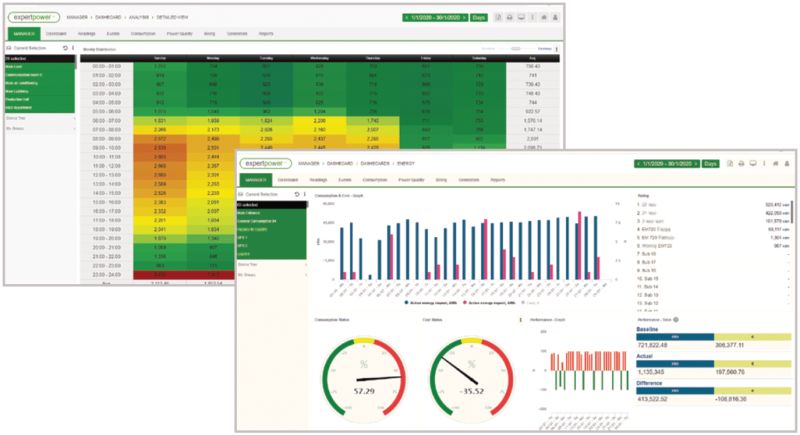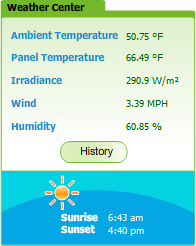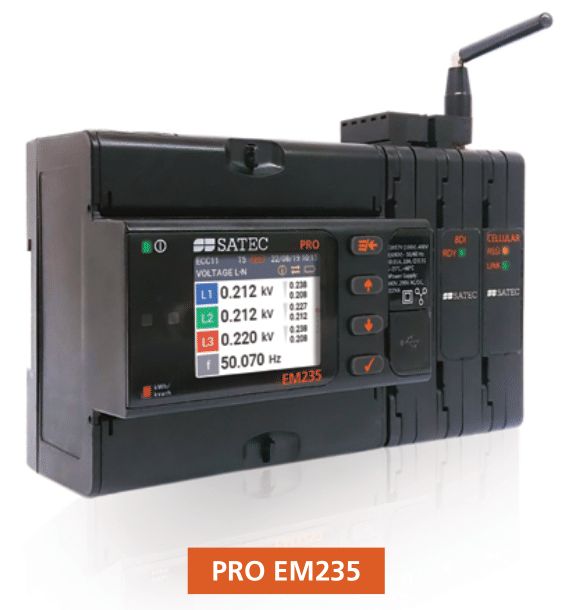The SATEC Renewable Offer
Worldwide Presence and Experience
SATEC offers solutions for renewable energy metering. The Siemens GAMESA Hybrid Park (Spain, solar & wind), Sinovel wind turbines (China), Perovo solar park (the Ukraine), EDF (France), IEC (Israel Electric Corporation) and Suzlon (India) are examples for SATEC projects. The SATEC system includes functionalities and advantages, corresponding with the challenges mentioned.
1. An Independent Metering System
Utilities often process erroneous calculations,2 overcharging for imported energy and underpaying for renewable energy exported to the grid.3 Placing a reliable and non-biased
revenue-grade SATEC meter at the connection to the grid guarantees supervision over the utility’s bi-directional TOU energy metering/billing. The EM720 is an ideal example of such an advanced
high-accuracy (Class 0.2S, per IEC 62053-22) revenue grade meter which combines power quality analysis as well (Class A, per IEC 61000-4-30).
2. An Accurate Metering System
Accuracy itself has a direct impact on revenue: a 1000 kVA transformer, operating at a typical 80% load, 0.9 PF, with electricity purchase at a
USD0.15/kWh rate is a typical scenario. With these parameters, the resulting difference between the allowed reading error for a Class 0.5 meter and a Class 0.5S (per IEC 62053-22) using SATEC HACS (High Accuracy Current Sensors) would translate to USD 9,461 annually (! for details, please refer to SATEC’s Accuracy Class application note).
Accordingly, all SATEC meters feature a minimum Class 0.5S accuracy (and Class 0.2S). Use of the HACS CTs, as a “One-CT” system, raises accuracy even beyond the mentioned standard, by eliminating the error factor of external CTs.
To illustrate this point further, basically, all PV panels rely on DC/AC inverters. These feature basic power metering functionality, often mistakenly seen as a reliable monitor. However, these readings are often far from accurate, starting at 2% accuracy with ideal loads, running through a typical 5% permissible error, reaching at times up to 50% permissible error. The above data is non- biased and is stated in official handbooks.
DC METERING
SATEC introduces additional accuracy and insight into the energy balance by offering DC metering capability (via Hall Sensors). Monitoring DC production current, prior to inversion, provides
a health-check on inverter efficiency and overall system architecture efficiency4 as well. This is available with SATEC’s PRO Series power meters, which feature advanced communication interfaces and functionality.
3. Optimization: An effective Production & Revenue Dashboard
SYSTEM EFFICIENCY
A comprehensive and accurate metering network ensures real-time monitoring of system
performance vs. its optimal architectural capacity, often hampered by malfunctioning equipment, dirty solar cells, shading or degradation of cells5 etc. This energy management system provides
a comparison of predicted vs. actual metered production, flagging any drop in production, locating the problematic component.
ENHANCED RESOLUTION
The more junctions of energy production designated as metering points, the higher the resolution. Increased system resolution enables obtaining a comprehensive energy balance / snapshot, detecting and pinpointing energy leaks or equipment failure along the internal network.
THE DESKTOP DASHBOARD
Expertpower is a software suite offered either as Software as a Service (SaaS) or as a standalone installation. Communicating with the physical
metering network, it is a dashboard displaying near-real-time data and analysis of production and revenue.
Expertpower is a versatile tool, providing different levels of analysis and allowing drill- down resolution into timeframes, up to 5-minute increments. Data is displayed in a variety of visual means: charts, graphs and heat-maps, facilitating anomaly detection. Irregularities are also flagged by alerts, which are sent out to designated users.
Designed as a modular platform, dashboards can be personalized and specified reports can be generated on demand. To enable retrofit and
integration with existing metering infrastructure, it is interoperable with equipment of any make.
REAL-TIME FINANCIAL DATA
The combined system (hardware and software) allows monitoring real-time data resulting in immediate and accumulative saving in energy, increased revenue and reduced carbon emissions

FORECASTING ENERGY PRODUCTION
Expertpower includes a module for prediction of energy production, based on system capacity and efficiency and weather forecasting. Production forecasting is extremely important for energy retail, especially for IPPs, which must report their forecasts to the dispatch and control center, setting their quota of supply vis-à-vis demand.
4. Power Quality
 Placing a SATEC Power Quality Analyzer, (revenue grade, such as the EM720/PM180) at the grid connection ensures detection of power quality deviations from standard such as upstream harmonics, outages, sags, swells etc., which harm equipment and hamper production.
Placing a SATEC Power Quality Analyzer, (revenue grade, such as the EM720/PM180) at the grid connection ensures detection of power quality deviations from standard such as upstream harmonics, outages, sags, swells etc., which harm equipment and hamper production.
Positioning a power quality analyzer at the grid connection also allows a producer to claim compensation from the utility for loss of production due to such equipment failure, due to faulty power quality. Deploying a metering network enables real-time monitoring of voltage
and current measurements, providing extra insight into the system’s power quality.
Inverters themselves include components which are prone to failure. These include capacitors, for example, which can dry out or burn due to external spikes in voltage. The result of this is increased harmonics, injected to the network.
Grid regulations normally limit tolerance of such harmonics at 8% THD, as set in EN50160.6 Anything beyond this, requires disconnecting the PV plant and loss of production. Flagging such inverters ensures unhampered production.
EXCEPTIONAL FREQUENCY RESOLUTION
The nature of the complicated integration of wind, solar or battery-stored energy into the utility grid requires rigorous monitoring of the frequency
of both generated power and grid frequency to which the power is introduced. SATEC meters delivers unique reading resolutions at 0.001Hz, at extremely high accuracy, enabling enhanced synchronization and minimal system idling.
Conclusion
With profitability and ROI being decisive factors
in justifying investment in renewable energy, the factors described must be addressed. Designing and integrating a SATEC control system will promote your energy production facility to the level of a true profit center.
Notes
Download PDF






 Placing a SATEC Power Quality Analyzer, (revenue grade, such as the EM720/
Placing a SATEC Power Quality Analyzer, (revenue grade, such as the EM720/